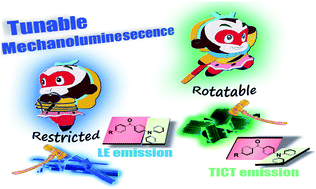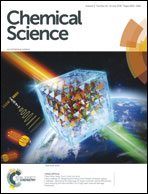Weak interactions but potent effect: tunable mechanoluminescence by adjusting intermolecular C–H⋯π interactions†
Abstract
A new mechanoluminescent material (4-(diphenylamino)phenyl)(4-(diphenylphosphanyl)phenyl)methanone (CDpP), which displays tunable mechanoluminescent emission colors, has been designed and successfully synthesized. CDpP shows two distinct mechanoluminescent colors (blue and green) in different crystalline states. Single-crystal analyses and femtosecond transient emission studies reveal that the striking tunable mechanoluminescence properties of CDpP mainly originate from the different C–H⋯π interactions in the crystal structures. CDpP crystals with more C–H⋯π interactions show blue mechanoluminescence (ML), and the emission is attributed to the locally excited (LE)-state because the twisting process for the excited state is restricted by C–H⋯π interactions. Conversely, CDpP crystals with fewer C–H⋯π interactions display green ML, in which the red-shifted emission band originates from the twisted intramolecular charge transfer (TICT) excited state because the diphenylamine moiety is relatively free to rotate. The manipulation of weak intermolecular interactions in the crystalline state is a useful and reliable strategy for the tuning of the ML emission wavelengths.



 Please wait while we load your content...
Please wait while we load your content...